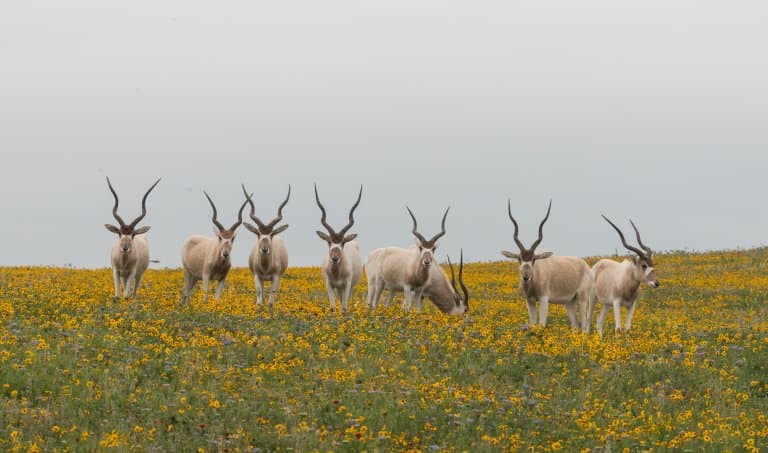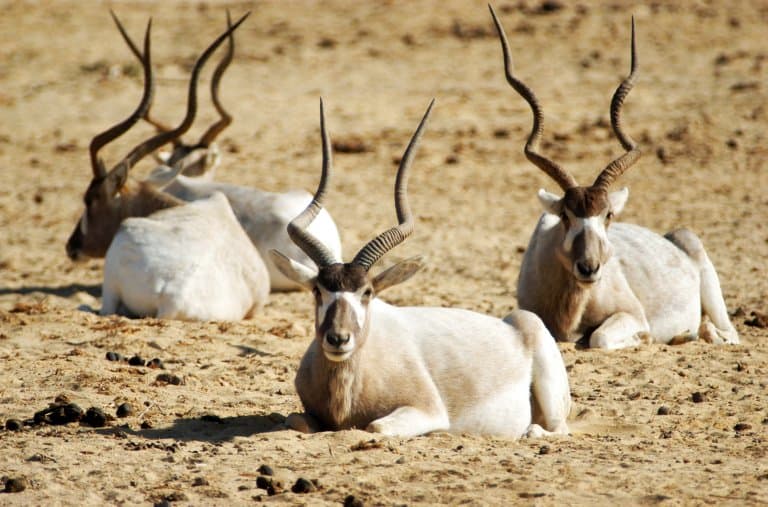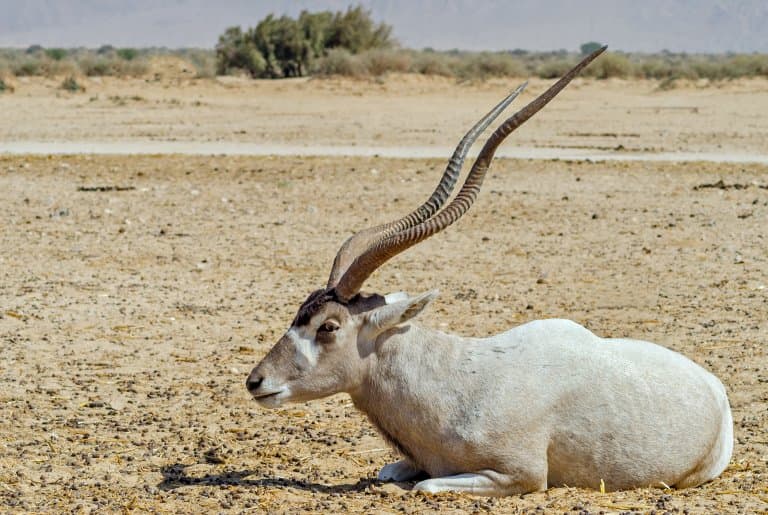Addax Profile
One of the rarest mammals in Africa is likely one you’ve never heard of.
The gentle Addax is an antelope that used to roam the Northernmost deserts of the continent, but has been tragically reduced to a fraction of its former glory.
The Addax is also sometimes known as the white antelope and the screwhorn antelope.

Addax Facts Overview
| Habitat: | Desert and stony arid regions |
| Location: | North Africa (Chad, Mauritania, and Niger) |
| Lifespan: | Around 19 years in captivity |
| Size: | Around 115cm tall, 170cm long |
| Weight: | Up to 150kg |
| Color: | Grey/brown in Winter, white in Summer |
| Diet: | Grasses and leaves |
| Predators: | Lions, leopards, cheetahs, wild dogs, humans |
| Top Speed: | Slow runner |
| No. of Species: |
1 |
| Conservation Status: |
Critically endangered (IUCN) |
Addax are, like their neighbours, well suited to the extreme conditions of the desert.
They have wide feet, barely need to drink, and can digest things that would scratch our insides to pieces – such as leaves from shrubs, herbs, bushes, as well as grasses.
They are mainly nocturnal, particularly in the summer when the desert is at its hottest. They will shelter from the sun in shady spots and dig into the sand to protect themselves from sandstorms.
These were popular, maybe even sacred animals to the ancient Egyptians, but their decline over the last century has left their numbers barely above double digits.
Thankfully, conservation efforts look promising, but it’s still going to be an uphill battle to save this pale antelope.
Interesting Addax Facts
1. They’re matriarchal
Addax form medium-sized herds of around 20 individuals. Both males and females have horns that twist in a corkscrew-like pattern, sometimes up to a meter long.
Females lead the herd, despite being slightly smaller than males. These slow-moving antelope are gentle desert warriors, which sadly makes them an easy target for humans, who have been easily catching them for thousands of years. 1

2. They are one of the ancient domesticated animals
Around 10,000 years ago, humans domesticated goats. Geese came not much later, at around 7000 years ago, and from ancient Egyptian artwork and hieroglyphs, the Addax can be seen as a somewhat domesticated animal from at least 5000 years ago.
They’re commonly present in the offering rows of Old Kingdom tomb decorations, suggesting that they were prized animals of sacrifice and that they weren’t simply objects of the hunt.
This all suggests that they may have been domesticated as early as horses were before even chickens made it to Egyptian gardens.
3. They’re sandy desert specialists
Like all desert species, the Addax is highly specialised. The desert is a low-productivity biosphere, meaning there’s not much growing in it, and this means animals need to build and evolve specific characteristics to allow them to make use of what they can get.
It’s also hot! And very sandy. So, they need special qualities for that, too.
Addax, therefore, has wide feet, to help it walk on the sandy substrate, and can dig into the ground when the temperature is too high.
They get most of their water from their food, which is handy. And they have a very developed system of digestion that allows them to get by.

4. They have extremely slow digestion
Grass has a lot in it. Cows are exclusively vegan and manage to put on hundreds of kilos of muscle from the relatively high protein content (around 25%) of young grass leaves. But the grass doesn’t give up its nutrients easily.
Cows and other bovids survive on grass because they’re ruminants: able to slow the passage of food through their gut, sometimes even vomiting it back into the mouth for a second round of chewing.
This extra time allows the teeth and the gut to thoroughly destroy the hard cellulose in the cell walls of their food, which is why their poop comes out like a wet soup, in contrast with, for example, a horse’s, which is much more closely resembles the grass that went int the front end.
Addax, as bovids, have this ability too. In fact, the Addax’s gut is far more adapted to breaking down the rough, slow-fermenting grasses of the African deserts. 2
As an adaption to a diet of rough grasses, their gut retains food for an average of around 42 hours. This is significantly longer than in cattle and gives the addax plenty more time to break down the cellulose and extract the nutrients inside.
They also hold onto water for longer than most mammals can, giving them less need to rely on the scarce water supplies of the Sahara. 3
5. They may be the third large African mammal species to go extinct in recent times
As a specialised animal, the Addax doesn’t have a lot of options. The downside to extreme speciality as a survival strategy is that the very precision that keeps an animal alive in their natural habitat restricts them from living any other way. 4
And with unchecked hunting, climate change’s impacts on their environment and the encroachment of farmland into their territories, the Addax are running out of hope. 5
Once spanning the width of North Africa, the territories of the Addax have been reduced to small populations in Chad, Morocco and Niger. Since the 19th century, it’s lost 99% of its original range.
These are slow-moving animals and no match for modern human hunters. Conservationists believe there are between 100 and 200 left in the wild, and along with the blue antelope and the scimitar-horned oryx, it may soon make up a trio of recent extinctions in North Africa.

6. They are an easy target for predators too
The addax’s languid movements make it an easy prey for its predators, which include, lions, leopards, cheetahs, and African wild dogs.
They aren’t aggressive animals and will often run away when threatened, but can occassionally charge.
7. Morocco has plans to introduce more
The scimitar-horned oryx, another fine beast, is entirely extinct in the wild, but reintroduction programs aim to change this.
Niger aims to save the few remaining Addax left as a significant part of the overall conservation efforts. 6
Morocco plans to resettle some of its Addax population to other locations, and Chad has been the location of a successful reintroduction of around 15 captive addaxes to their native habitats.
These fifteen individuals will be closely monitored with tracking collars for conservationists to glean vital information into the behaviors and habits of one of the most endangered animals of modern times.

8. There are more addaxes in captivity than in the wild
Much of what we know about this animal comes from captive populations. As the Egyptians discovered over 5000 years ago, Addaxes adapt well to captivity and are quickly tamed. 7
As such, there are over ten times as many across the world in various zoos and ranches. Roughly 2000 addaxes in captivity hold the vast majority of the genetic diversity of the species, and plenty to form viable populations for reintroduction. 8
This makes their success feasible, but the constant battle against poachers, and the indirect impacts of encroachment and climate change will remain a challenge and require all stakeholders to get involved and collaborate.
Addax Fact-File Summary
Scientific Classification
| Kingdom: | Animalia |
| Phylum: | Chordata |
| Class: | Mammalia |
| Order: | Artiodactyla |
| Family: | Bovidae |
| Subfamily: | Hippotraginae |
| Genus: | Addax |
| Species: | Addax Nasomaculatus |
Fact Sources & References
- Asa Strandberg (2009), “The Gazelle in Ancient Egyptian Art”, Uppsala .
- “Souss-Massa National Park”, National Parks.
- Jürgen Hummel (2007), “Fluid and particle retention in the digestive tract of the addax antelope”, Science Direct.
- “Addax”, Endangered List.
- Elisabeth Hempel (2021), “Diversity and Paleodemography of the Addax (Addax nasomaculatus), a Saharan Antelope on the Verge of Extinction”, NIH.
- “Saint Louis Zoo Participates in Reintroduction of Addax in Chad”, Association of Zoos & Aquariums.
- (2022), “To save the addax antelope, the oil sector and government must work together with conservationists,” IUCN.
- Alina Bradford (2016), “Addax Facts: Endangered Antelope Faces Extinction”, Live Science.
